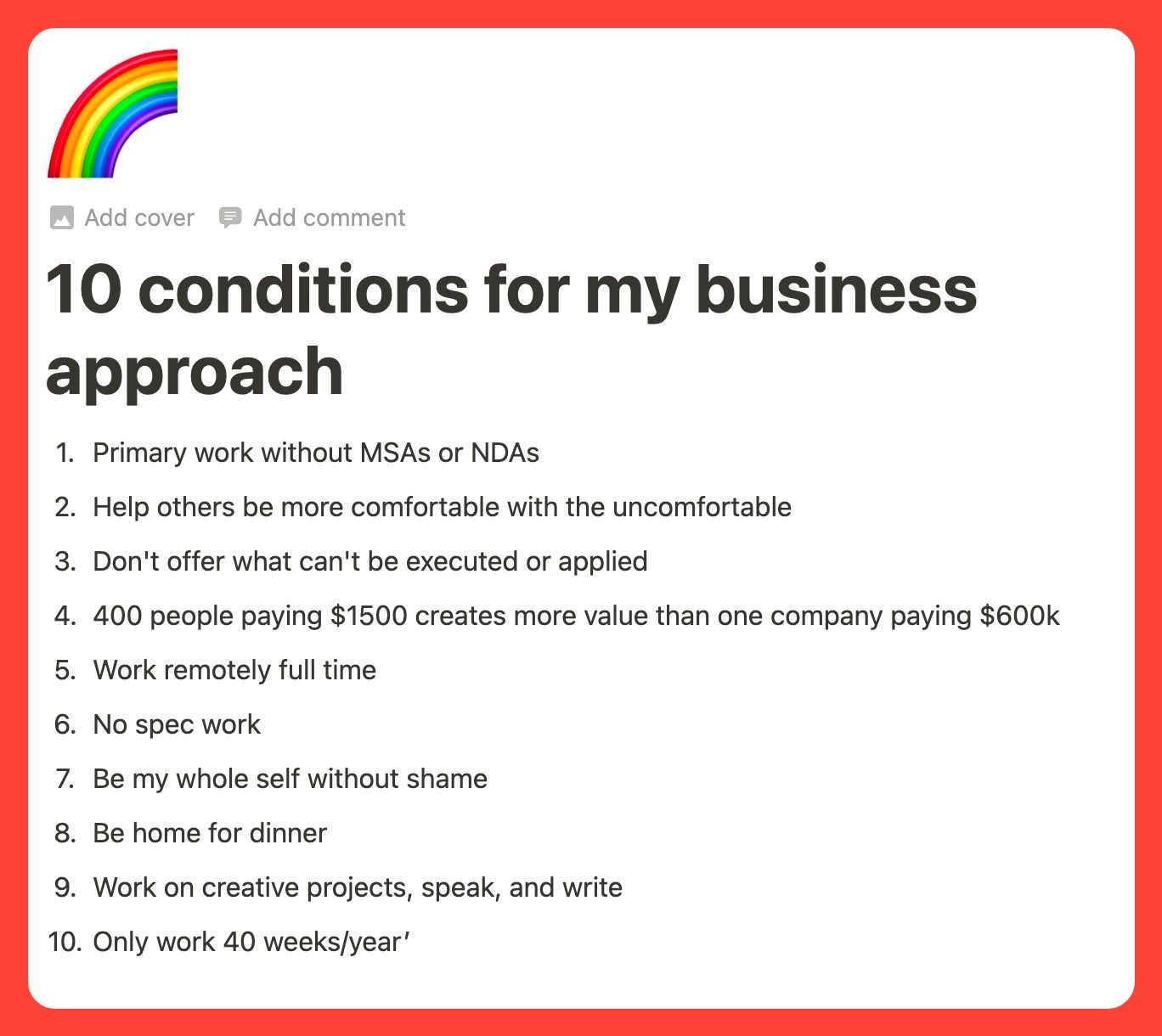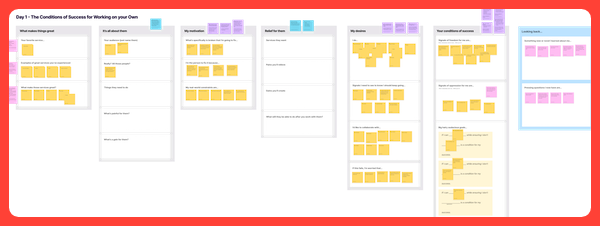The first thing I made for Second Wave Dive, before doing any market analysis, business model testing, setting up my company, workshopping, designing, branding… any of it, was writing down 10 conditions for my business approach.
Here's a screenshot of that document.

I didn't know what I was doing when I made this. I didn't have a tool or a template. I just knew that the conventional approaches for business were failing my friends and peers who took similar leaps.
- Friends who were spending 50% of their time creating invoices, trying to get paid, caught up in contracts, filling out NDAs
- Peers whose livelihoods depended on big-ticket contracts with companies, only to have those projects canceled a week before they started
- Friends who constantly had to hire and layoff employees because projects would quickly spin up or quickly get cancelled
- Peers who had to spend 80 hrs/week trying to get one sale and struggling to get any traction
- Friends who spent a lot of money upfront to get certified with a credential and made a big announcement of how excited they were to offer their new service… only to be met with silence, no customers at all
- Peers who had bills to pay, mouths to feed, or college to afford who spent a lot of emotional energy thinking about how they were going to make it work
- Friends who eventually had to start looking for a full-time job to make ends meet
- Peers who lost all of that excitement, their zeal for life while they tried to make this work
All of these things scared me. I wanted to do what I could to avoid these scenarios. After working in-house for 15 years, I wanted to spend my time doing things that lifted and gave me energy because I knew that would help lift and energize those who worked with me. Because if working for myself didn't do these things, I might as well be working for someone else.
I turned to many conventional thinking and lessons for starting a business, being a business owner, making products/services that help people, and finding a pricing point. I consumed just as much material for leading a meaningful life. Whether it was through therapy, or self-reflection, books, or courses. I did quite a bit of research and tried a bunch of stuff.
And I noticed something significant, a gap.
- The conventional business lessons and teachings I saw left out any mention of leading a meaningful life
- The lessons and teachings that focused on a meaningful life left out important, applicable business fundamentals
If I was going to start my own business, I HAD to succeed in both for this to work.
And because there wasn't a straightforward answer, I had to try a different approach. The 10 conditions are simply an output of that different approach.
How I came up with those 10 conditions
Before SWD, I did a bit of writing and gave a couple of talks about designing my life. As a methodology, designing is about rendering intent to solve a problem. In 2003, I started experimenting with design techniques to make more deliberate choices in my life. In one of those experiments, I created a quick reflection workshop and asked four basic questions:
What are the problems I am currently having?
Are there any missed opportunities right now?
What is going right with me?
What is just “plain important” to get right?
The 10 conditions for my business approach came from answers to these questions. The conditions were answers to problems I was having or things that were going right that I wanted to continue getting right.
- Primary work without MSAs or NDAs (problem I was having)
- Help others be more comfortable with the uncomfortable (going right)
- Don't offer what can't be executed or applied (plain important)
- 400 people paying $1500 creates more value than one company paying $600k (plain important)
- Work remotely full time (missed opportunity)
- No spec work (going right)
- Be my whole self without shame (plain important)
- Be home for dinner (plain important)
- Work on creative projects, speak, and write (missed opportunity)
- Only work 40 weeks/year (problem I was having)
One of the biggest lessons I learned at Apple was to plant some basic expectations around yourself before you begin so you can freely explore how to meet them in various ways. Setting these 10 conditions for myself up front has influenced every single decision I've made since. From doing my business model/strategy work, thinking about meeting customer expectations, positioning, branding, writing, operations… all of it.
Why am I telling you this?
When anyone asks me how I started SWD, I share a bunch of things like the original competitive analysis I did, the testing and workshopping I completed, how I largely ignored my branding the first few years, and how I thought about automating a bunch of operational things. Of all the things I share, it's these 10 conditions that stand out for people.
While this approach seemed perfectly normal for me as someone who had been using design techniques on himself for 15 years, I discovered it's a novel approach for others. It's not new in the sense that the techniques exist and the activities are quite basic. It's different because I focused on having a meaningful life and making a decent living simultaneously. This approach really seems to click for others when I've shared it.
When Greg and I started workshopping what Jump Ship as a company might be, I walked Greg through these same activities before we started. It was a small chance for me to test whether or not it was learnable and see if this hit differently for Greg. It did.

Right now, we're calling the activity "Yays and Nays". Right now, this is the first activity we do with others before we get into business-y stuff.
Have a good weekend y'all.
R
P.S. If you enjoy this and want to keep up with our latest updates on Jump Ship, follow along. If you know someone who might like this too, forward this to a friend. :)

